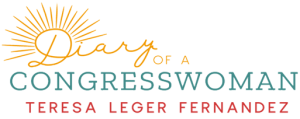Mary-Charlotte Domandi:
So I wanted to ask you today about the infrastructure plan, trillions of dollars will be going into this. And I was wondering if you could talk about the process whereby we as a nation, you as Congresspeople, the president and the administration, all come together to decide what goes into a major infrastructure bill like this.
Teresa Leger Fernandez:
So part of it is that we need to remember that a new president, a new Congress, doesn’t happen from nothing. We are now in the 117th Congress, but we had the 116th Congress and in the 116th Congress, the Democrats really were looking at many of the issues that they thought were important to be able to address COVID, to be able to address a lot of the structural inequities in the country and, in infrastructure, the structural deficiencies in the country. So there has been talk about an infrastructure bill for a long time. And there has been a long recognition of the fact that so much of our infrastructure is rated C and D and F. There’s a rating that is made by engineers every year, and it ranks different pieces of infrastructure. That’s similar to, I would say the way the American Rescue Plan built upon the Heroes Bill that the Congress had worked on last year.
So that’s an important thing to remember, that we are always building upon work that had been done before. And so that is part of what’s happening now, is that there has been discussion of what’s needed in terms of infrastructure for years. And so these are projects that have been raised and discussed over time. Now I am coming in and I want to say, well, wait a minute, What about things I identify, right? And so there is indeed a process by which I can identify important infrastructure that I think needs to be funded. And so we just did a letter to the president that we sent out last week saying in your Build Back Better bills we think, you need to pay attention to these kinds of things. We wanted to focus, especially on issues around the transition to a clean economy and the need that we need to be able to diversify our economy.
And that means actually building infrastructure. And we also focused on broadband. So we know that there will be a significant broadband piece in the bill. That’s an example, right? There has been a rural broadband taskforce that existed in past congresses. It was reconstituted in this Congress. I was asked to sit on that task force and we put together a bill that has $10 billion worth of broadband funding for the next 10 years, like 10 billion a year. So that’s how you ended up with the children as you do that over time. So that’s kind of how it is. It’s like we build upon it. Now the president came in and he looked at what has congress been talking about? What have I been talking about on the road? What have communities been coming to me, the president, about and raising and what are our priorities? And so that’s, what’s been going on, is people have been going to the president and saying, listen, if you want to carry out these priorities that you said in your speeches, this is what’s required.
And the neat thing is I gave a Tea for Teresa soon after we got hit by the COVID. So it was last summer, 2020. And we talked about the need to have infrastructure, not just be roads and bridges, which are important, but also the things that we need for community to thrive. So that’s roads and bridges and health clinics and broadband and housing and schools and daycares. And so the wonderful thing is that by the time we got to the presidential election, if you look at what Biden said in his presidential election, he wants to fund things that include all of that. So that’s how it happens is in a presidential election, everybody’s saying the ideas and arguing and putting forth their ideas and what president Biden did was take ideas that other candidates had raised. All of that got incorporated into the platform, at the Democratic convention. And then that is now part of what he is going to be proposing. So he is still taking suggestions.
MCD:
One of the things I was thinking about was daycare, elder care. We desperately need that kind of infrastructure. Those are notoriously underpaid professions. I mean, we were talking about pay equity the other day; is it built in to make those professions actually better paid and better working conditions and more respect for the people who are in them, the workers?
TLF:
So some of those things, you cannot legislate. You can’t legislate respect. But you can pay people more, which is an indicia of respect. There are likely to be two different kinds of bills. One will be an infrastructure bill that is about things you built. And then there’s going to be an infrastructure bill that is about human capital–the fact that we also need to invest in the people that are going to work in those daycare centers and eldercare centers, and that we have to pay them appropriately and that we have to train them and provide them certification and make sure that they have access to federal grants, like the Pell grant, that are available if you’re going to college. We need to make sure that they are available for the wide range of human development that we need to help our communities thrive and to best use this infrastructure we want to build.
So yes, that is exactly part of the plan. You get to a point though, where you set a minimum wage at $15 an hour, then that becomes your floor. And then the more certifications and requirements that you build, and hopefully then we are starting to pay people higher than that because the minimum wage might be, if you don’t have any of those certifications, you don’t have any of that training. But then you get certain levels of training and you should then be able to get paid more. And so that’s why there is money in different places, but in the American Rescue Plan for paying people to be able to get these certifications and sending the money to the governments or the agencies or the nonprofits to be able to operate and pay people.
MCD:
What are some of the things you’re pushing for with respect to New Mexico, which would presumably benefit other states with similar issues to our own state.
TLF:
We are pushing on the energy transition. We are pushing really hard that we invest in the industry and human capital that we need so that we actually can transition away from fossil fuel without sacrificing New Mexico’s economy and New Mexico’s children. So we have a very specific request that we fund the energy infrastructure, the Route 66 of renewable energy, because that requires infrastructure, that we fund broadband, that we fund the kind of diversification that we’ll need. For example, Farmington would really like a railroad because they are connected by pipeline to the rest of the world, but there is no railroad from Farmington to Gallup, where they could tie into the railroad. The agricultural products from up there, they could do manufacturing, so they don’t have a way to ship their material. So that’s the kind of project that, that would be a good diversification project that we would like to get funded through this bill. Now that might be too specific. We might not be able to get all of that done, but we might be able to get something moving in that direction. Farmington, San Juan, has asked me about that and I am pushing that. That’s a specific request I’ve left.
MCD:
You’re also looking at the arts and seeing that as part of a kind of infrastructure plan. How do you think about that? How does that work?
TLF:
I love that you raised that. So my lettuce specifically asks the president, and we have legislation that we are introducing, that recognize that in New Mexico, one in ten New Mexicans receive income from the arts, from the creative economy. So this pandemic has really hurt the arts. And let’s remember the Great Depression, the WPA projects, all those beautiful murals and those photographs and the Smithsonian gathering stories and songs all over America, that those are wonderful pieces of legacy that we have now. Well, I think we need to fund that today, because there are so many artists and performers and writers and playwrights and poets and muralists who have lost their income. And if we could fund those so that we actually then build upon the cultural celebration that exists everywhere. After the great depression they collected the songs and the stories in Appalachia, the same way they collected the songs and the stories from Northern New Mexico. That was great for both of those cultures, which are included in the great American culture. So I am very excited about that project. And I see that as part of infrastructure, a part of building back in a way that allows everybody to celebrate the rich and very different and diverse cultural expressions we have in the United States.
MCD:
So the price tag is in the trillions. And if I understand correctly, at the moment we’re basically, as they say, printing money. What are the repercussions of that? Is there an accompanying tax revenue plan that goes along with this, because there’s obviously fears of inflation and things like that. How are you seeing that?
TLF:
There is going to be the need to raise revenue, to pay for some of this. But we also need to be careful about those who say, we cannot have deficits. Deficits are a problem if you have inflation. But if you don’t have inflation, they’re not the big boogie man that the Republicans make them out to be. And I think that we need to be fiscally aware of what’s happening, but there are a lot of good economic thought, which is very complex that I love reading about, that talks about when does it make sense to do the kinds of investments. And this is precisely that kind of time, because what you do is by doing these investments, you get the economy running, people say hot, right? But if it’s running hot, it also then starts to generate revenues and to generate revenues, including tax revenue.
And that’s the opposite of the trickle-down theory. So the tax cuts that the Trump administration passed and that Republicans have passed, and every time they come into office, they do these tax cuts for the wealthy and for the wealthiest of corporations. And the idea is that it’s going to trickle down to the rest of us. And it’s been proven that never works. But this kind of investment does generate additional tax revenues. So the investments itself, they do generate revenue. And I’m going to end with this: If people are worried about raising revenue, if we pass the comprehensive immigration reform, that would raise $1.3 trillion. So that’s one way of paying for this is doing right by the immigrants.
MCD:
How would it raise so much money?
TLF:
Because when you bring immigrants out of the shadows, they invest in businesses, they invest in buying houses. They’re no longer worried about their status and they are able to participate more fully in the economy. The last time we did immigration reform, we had a $1.4 trillion economic benefit to the United States. So this one is estimated at 1.3 trillion.
MCD:
And I think that’s a good place to end for today. Thank you.
New Speaker (12:51):
Okay. Thanks.


